#Luis Felipe Miguel
Explore tagged Tumblr posts
Text
instagram
1 note
·
View note
Link
0 notes
Text
#el ministerio del tiempo#emdt#emdt polls#benito pérez galdós#luis berlanga#federico garcía lorca#carmen polo#francisco franco#pedro almodóvar#antonio banderas#fabio mcnamara#fabio de miguel#felipe iv de españa#henry bedingfeld#polls
6 notes
·
View notes
Text
Llamando a Laura Ferro: ¡Despertad despiertos!
Llamando a Laura Ferro: ¡Despertad despiertos!
Llamada de alerta a los “despiertos”. Laura Ferro nos advierte de la gran trampa del alma y de la espiritualidad que muchos que se consideran despiertos practican. Cuidado con el Amor, con la Compasión, nos mantiene atrapados. Por contra los valores más elevados son el honor, la lealtad, la camaradería y el mantener la palabra dada. La filóloga Laura Ferro te romperá, sin ninguna duda, muchos…
youtube
View On WordPress
#espiritualidad falsa#Gnosis#Laura Ferro#Luis Felipe Moyano#Miguel Celades#Reiki#Sabiduria hiperboria#Youtube
0 notes
Text
DÍAS DE GUARDAR Domingo 3 de septiembre de 2023
Arte: Emilio Jiménez a través de MidJourney La maquinación que provocó una huelga universitaria Márquez bajo fuego: venganza sin rendición de cuentas Llega nuevo delegado de la FGR a Guanajuato Continue reading Untitled

View On WordPress
#Claudia Susana Gómez#Designación de rector#Diego Sinhue Rodríguez#Fiscalía General de la República#Julio César Kala#Luis Felipe Guerrero Agripino#Miguel Márquez Márquez#Ruptura Política#Universidad de Guanajuato
0 notes
Text
Brazil wins 19 medals in international math competition

Six students from the Mathematics Department of the Scientific Technical Center of the Pontifical Catholic University of Rio de Janeiro (PUC-Rio) won six medals at the 31st International Mathematics Competition for University Students (IMC), held in Blagoevgrad, Bulgaria, from August 5–11.
The medals bagged by the PUC-Rio team gave the university first place among the six Brazilian institutions that took part in the event in this edition. There were two gold medals, corresponding to two first places in the competition for Brazil, as well as two silver and two bronze medals. Miguel Batista and Luis Felipe Pestana Giglio won gold.
Nineteen medals were won by Brazilian university students at the IMC altogether—three gold, nine silver and seven bronze. The other participating Brazilian institutions were the Getulio Vargas Foundation of Rio de Janeiro (FGV Rio), the University of São Paulo (USP), the Technological Institute of Aeronautics (ITA), the Federal University of Ceará (IFC), and the Federal University of Pernambuco (UFPE).
Continue reading.
#brazil#brazilian politics#politics#math#math olympics#DID YOU SEE MY BAG DID YOU SEE MY BAG IT'S HELLA TROPHIES AND IT'S HELLA THICK#image description in alt#mod nise da silveira
23 notes
·
View notes
Text

"Los Olvidados" es considerada la cinta culpable del declive de la época de oro.
Estuvo sólo tres días en cartelera, la prensa y la clase alta estaban vueltas locas, querían quemar a Luis Buñuel y todo lo que oliera a él.
Era 1950 y el cine mexicano estaba en su esplendor , el cineasta español Luis Buñuel ya tenía éxito, pero estaba enamorado de nuestro país, grabada en Nonoalco, en lo que entonces eran los límites norteños de la Ciudad de México. Y tenía un propósito, una visión desgarradora de los niños de la calle en las grandes urbes; Aquellos de los que nadie habla, los que callan, los olvidados.
CINE
El poeta Octavio Paz escribió: “Pero Los Olvidados es algo´más que un filme realista. El sueño, el deseo, el horror, el delirio el azar, la porción nocturna de la vida, también tiene su parte. Y el peso de la realidad que nos muestra es de tal modo atroz, que acaba por parecernos imposible, insoportable. Y así es: la realidad es insoportable; y por eso, porque no la soporta, el hombre mata y muere, ama y crea”.
Su nombre original era "La Manzana Podrida" y en realidad, no tenía ningún nombre de peso, se tenía a Estela Inda, Miguel Inclán y Alfonso Mejía, además de un grupo de niños comandado por Roberto Cobo, un chico que había salido como extra en varias cintas y un día que audicionó para una película de Tin Tan se enteró que Buñuel estaba entrevistando para su nuevo filme, hizo la audición y se quedó con el rol de “El Jaibo”.
DORADO
Sin embargo, desde su inicio, la cinta tenía problemas, dentro y fuera. El productor Oscar Dancingers se opuso a que se incluyeran muchos detalles que resultaban amorales; Jorge Negrete, líder del Sindicato de Actores, quería evitar su grabación e instó a técnicos y camarógrafos a abandonarla; una de las peinadoras renunció por la escena en que la madre de Pedrito, le niega la comida.
Pedro de Urdimalas, escritor de la cinta al lado de Buñuel, pidió que su nombre no apareciera en los créditos y en la primera función privada que se hizo, Lupe Marí, esposa de Diego Rivera, y Bertha, esposa de León Felipe, reclamaron al director que era un miserable y lo que mostraba no era México. David Alfaro Siqueiros por su parte aplaudió el trabajo asegurando que Luis era un genio nacido para el cine.
MX
Los Olvidados era la primera producción sería de Luis Buñuel y quería hacerlo todo al máximo de sus posibilidades, la filmó en 21 días entre el 6 de febrero y el 9 de marzo de 1950, pero aunque la cinta es posiblemente una de las más galardonadas de su cine, él solo recibió dos mil dólares por ella y no pudo participar en las ganancias de la misma.
Ante las críticas, Buñuel respondió durante una entrevista que estaba orgulloso de su filme “La libertad total no existe, yo jamás he sido libre, yo soy libre cuando cierro mis ojos y estoy conmigo mismo sin que sepa que ya estoy viejo; El sistema de inconformidad es esa tendencia a romperse la cabeza por recuperar la propia libertad, lo que es imposible, es por tanto una inconformidad permanente de la realidad exterior”.
En los albores de los 50, el presidente mexicano Miguel Alemán estaba planeando la industrialización en el país, para dejar atrás la agricultura como primera fuente de recursos de los nacionales, pero el cine estaba en su apogeo, por ello las reacciones ante la cinta eran tan violentas.
Se tiene registro de que algunos cines fueron destruidos por los asistentes al estreno en noviembre de ese 1950, los fanáticos salían furiosos, la llamada “Liga de la Decencia” intentó expulsar a Buñuel del país y aunque no lo lograron, el director si dejó el territorio.
CINE
A pesar de los múltiples problemas, Luis Buñuel estrenó su cinta en Europa y la crítica mexicana tuvo que aceptar la gran equivocación cuando el gran jurado del Festival de Cannes le dio el premio como Mejor Director en 1951.
La película tiene una trama dura, y a diferencia, por ejemplo de "Nosotros los pobres" no busca causar lástima sino presentar una realidad diferente a la que se creía que existía en el país.
La historia nos lleva por los barrios más pobres de la Ciudad de México, donde los niños de la calle son una plaga para las altas esferas de la sociedad. Jaibo (Roberto Cobo) es un adolescente que escapa de un correccional para reunirse con Pedro (Alfonso Mejía). En presencia de él, Jaibo mata a Julián, el muchacho que supuestamente le delató. También intenta robar a un ciego (Miguel Inclán) al que finalmente maltrata. Acompañados de Ojitos y Meche (Alma Delia Fuentes), el destino del Jaibo y Pedro están marcados por la muerte."
DORADO
Para muchos expertos en cine de la época consideran que la película terminó con idiosincrasia qué se tenia de México en el extranjero, México había pasado de ser la nación rural donde el romanticismo ranchero era el emblema, las comedias rancheras pasaron a ser del pasado, para dar paso al verdadero país que se tenia olvidado, una sociedad muy corrompida.
Sin embargo la nueva forma de hacer cine gracias al ojo del director Buñuel, con el paso de los años se fueron realizando producciones crudas sobre la sociedad mexicana.
MX
Si bien el termino de la era dorada del cine fueron más factores internos y externos, como la sobre explotación de comedias rancheras, la pobreza de recursos y el que Estados Unidos de alguna manera haya retomado la industria cinematográfica después del conflicto mundial.
epoca de oro Los Olvidados luis buñuel
Cine Mexicano Cine Dorado Mx
22 notes
·
View notes
Text
“La abundancia de las cosas, aunque sean buenas, hace que no se estimen, y la carestía, aun de las malas, se estima en algo”
Miguel de Cervantes
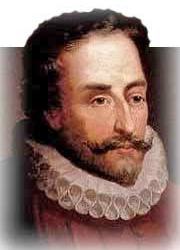
Fue un novelista, poeta, dramaturgo y soldado español, nacido en Alcalá de Henares en septiembre de 1547, ampliamente considerado como una de las máximas figuras de la literatura española.
Su padre se llamaba Rodrigo Cervantes y su madre Leonor de Cortinas, de quienes poco se sabe de sus vidas. Se asume que nació el 29 de septiembre dado que en ese tiempo se acostumbraba darle el nombre a los niños por el dia de su nacimiento, siendo la fiesta de San Miguel Arcángel ese día.
Tampoco existen datos precisos sobre los primeros estudios de Miguel de Cervantes, que sin duda no llegaron a ser universitarios, por lo que se asume, pudo haber estudiado en Córdoba o Sevilla.
En 1566 se estableció en Madrid, era amante del teatro y asistía a las representaciones de Lope de Rueda, un dramaturgo español de gran versatilidad.
Sin tener confirmación de si se trata de un homónimo, existe una providencia de Felipe II que solicita la aprehensión de Miguel de Cervantes por herir a un obrero en un duelo, situación que podría justificar su estancia en Italia, algunos autores como Ludovico Ariosto o León Hebreo influirían en el Don Quijote.
En Italia se pone al servicio de Giulio Acquaviva, un eclesiástico italiano a quien le siguió por Palermo, Milán, Florencia, Venecia, Parma y Ferrara. Después de ello ocupó una plaza como soldado en la compañía del Capitán Diego de Urbina del tercio de Miguel Moncada, en donde participó en la batalla de Lepanto en octubre de 1571.
Derivado de la batalla de Lepanto, Miguel de Cervantes pierde el movimiento de su brazo izquierdo cuando un trozo de plomo le seccionó un nervio, de donde adquiere el apodo de “El manco de Lepanto”.
Cervantes reanuda su vida militar en 1572, formando parte en multiples expediciones navales y recorriendo las principales ciudades de Sicilia, Cerdeña, Génova y la Lombardía.
Durante su regreso desde Nápoles a España, Cervantes es hecho prisionero y tomado en cautiverio y llevado a Argel, en donde solicitarían un rescate de 500 escudos de oro, pues creían que se trataba de una persona muy importante para el reino derivado de unas cartas de recomendación que poseía.
En casi 5 años de aprisionamiento, Cervantes intentó escapar en 4 ocasiones sin éxito, y es ahi, en donde se piensa que surgió un parteaguas entre su vida y la literatura, hasta que en septiembre de 1580, Cervantes es liberado regresando por fin a España, en donde esta experiencia vería reflejada en sus trabajos titulados; “El trato de Argel”, “La Galatea”, y en “Los trabajos de Persiles y Sigismunda”.
Es muy probable que entre los años 1581 y 1583, Cervantes escribiera “La Galatea”, su primer obra literaria en volumen y trascendencia.
Cervantes se establece en Sevilla en 1587 en donde fue comisario de abastos de los barcos reales, los cuales le causaron multiples problemas con los campesinos, pues los impuestos que recaudaba básicamente eran para cubrir las deudas de la guerra, sin embargo esto le permitió conocer el abigarrado y pintoresco mundo del campo, el cual reflejaría magistralmente en el Quijote.
En 1597 Cervantes es encarcelado tras sospecha de malos manejos en las cuentas que administraba para recaudar impuestos y es en la cárcel, en donde engendra la primera parte de su célebre novela “Don Quijote de la Mancha”, según prólogo de esta obra. No se sabe a ciencia cierta si con ese término quiso decir que comenzó a escribirlo mientras estaba preso o simplemente que la idea se le ocurrió en prisión.
La primera parte de su obra “El ingenioso hidalgo, Don quijote de la Mancha” apareció en 1605; en donde el éxito de este libro fue inmediato y considerable, sin embargo poco le sirvió para salir de la miseria.
Mientras los grandes poetas del siglo de oro como Francisco de Quevedo, Lope de Vega o Luis de Góngora gozaban de una sólida posición y de la protección de la aristocracia, Cervantes tenía que seguir a la Corte a donde se estableciera para poder seguir mendigando favores. La difusión del Quijote solo le sirvió para publicar otras obras que ya tenía escritas como Las Novelas Ejemplares, el Viaje del Parnaso y Comedias y Entremeses.
En 1615, meses antes de morir, envió a la imprenta el segundo tomo del Quijote, completando la obra que lo situaría como uno de los mas grandes escritores de la historia y como el fundador de la novela en el sentido moderno de la palabra.
Cervantes murió en Madrid a la edad de 68 años de diabetes. Su cuerpo fue enterrado en el convento de las trinitarias descalzas, ya que cuando fue llevado preso a Argel, fue la congregación de los trinitarios quienes ayudaron a pagar su rescate, recogiendo fondos para que el y su hermano Rodrigo fueran liberados.
Fuente: Wikipedia y biografiasyvidas.com
#españa#siglo de oro#escritores#novelistas#citas de escritores#frases de reflexion#frases de escritores#dramaturgos#citas de poetas#frases de poetas#poetas en español#poetas
7 notes
·
View notes
Text
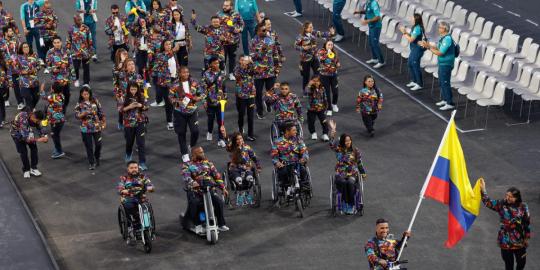
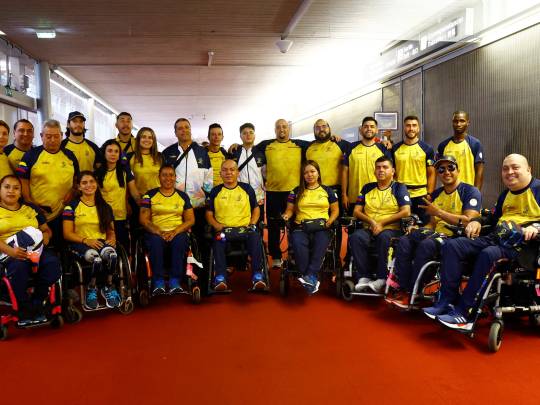
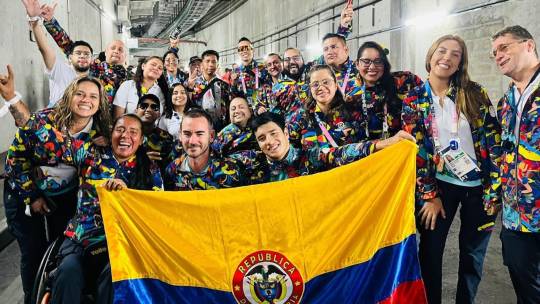
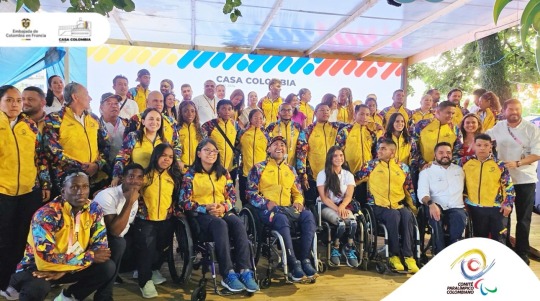
A bit late but couldn't forget about them, our Paralympics delegation. They absolutely killed it. Every single one of them giving it all and making us proud.
Thank you to all of our 78 participants, 28 medalists, and 44 diplomas.
Alex Enrique Martínez Guevara, Ana Lucía Pinto Ochoa, Andrés Felipe Mosquera Neira, Angie Lizeth Pabón Mamian, Aura Cristina Poblador Granados, Bertha Cecilia Fernández Arango, Brayan Mauricio Triana Herrera, Buinder Brainer Bermúdez Villar, Carlos Andrés Vargas Villanueva, Carlos Daniel Serrano Zárate, Daniel Giraldo Correa, Daniela Carolina Munévar Flórez, Darian Faisury Jiménez Sánchez, David Felipe Rendón Acosta, Diego Fernando Meneses Medina, Edilson Chica Chica, Edwin Fabián Matiz Ruiz, Eglain Antonio Mena Lemus, Erica María Castaño Salazar, Euclides Grisales Diaz, Fabio Torres Silva, Francy Esther Osorio Calderón, Fredy Duvian López Morales, Gabriela Oviedo Rueda, Giovanny Andrés Malambo Rachez, Gisell Natalia Prada Pachón, Héctor Julio Ramírez Murcia, Ionis Dayana salcedo rodríguez, Jesús Alberto López, Jesús Augusto Romero Montoya, Jhohan Darío Ardila Cárdenas, Jhon Alexander Hernández García, Jhon Eider González Hernández, Jhon Fredy Gómez Giraldo, Jhon Sebastián Obando Asprilla, José Gregorio Lemos Rivas, Juan Alejandro Campas Sánchez, Juan David Pérez Quintero, Juan Esteban García Sánchez, Juan Esteban Patiño Giraldo, Juan José Betancourt Quiroga, Julián Andrés Jaramillo Téllez, Karen Tatiana Palomeque Moreno, Kevin Alfonso Moreno Gualaco, Laura Carolina González Rodríguez, Leider Albeiro Lemus Rojas, Leidy Johanna Chica Chica, Lino Nicolás Coca Castro, Luis dahir Arizala Ocoró, Luis Fernando Lara Rodallega, Luis Fernando Lucumí Villegas, Luis Francisco Sanclemente, María Alejandra Murillo Benítez, María Angélica Bernal Villalobos, María Mónica Daza Guzmán, María Paula Barrera Zapata, María Salomé Henao Sánchez, María Teresa Restrepo Rojas, Mariana Guerrero Martínez, Mauricio Andrés Valencia Campo, Mayerli Buitrago Ariza, Miguel Ángel Rincón Narváez, Nelson Crispín Corzo, Niver Rangel palmera, Paula Andrea Ossa Veloza, Reynel Romero Montoya, Santiago Solis Torres, Sara del Pilar Vargas Blanco, William Jair higuera Ocampo, Xiomara Saldarriaga Hernández, Yamil David Acosta Manjarrez, Yasiris Blandón Escobar, Yeferson Suárez Cardona, Yeniffer Paredes Muriel, Yesenia María Restrepo Muñoz, Yesica Paola Muñoz Nieto, Zharith Alejandra Rodríguez Silva, Zuleiny Rodríguez Trujillo
#paralympics 2024#colombia#comité paralímpico colombiano#colombian paralympic committee#(nightmade)#this was my first time actually watching the paralympics games#it was amazing#I'm saddened that they don't get as much noise as the other games#like we won 9 times more medals and yet the news nothing
3 notes
·
View notes
Text
People primarily noted for their long names on Wikipedia:
Leone Sextus Denys Oswolf Fraudatifilius Tollemache-Tollemache de Orellana Plantagenet Tollemache-Tollemache (British Army officer of WWI) and elder brother Lyulph Ydwallo Odin Nestor Egbert Lyonel Toedmag Hugh Erchenwyne Saxon Esa Cromwell Orma Nevill Dysart Plantagenet Tollemache-Tollemache. The last name is pronounced /ˈtuːlmeɪk ˈtɒlmæk/.
Alfonso María Isabel Francisco Eugenio Gabriel Pedro Sebastián Pelayo Fernando Francisco de Paula Pío Miguel Rafael Juan José Joaquín Ana Zacarías Elisabeth Simeón Tereso Pedro Pablo Tadeo Santiago Simón Lucas Juan Mateo Andrés Bartolomé Ambrosio Gerónimo Agustín Bernardo Cándido Gerardo Luis-Gonzaga Filomeno Camilo Cayetano Andrés-Avelino Bruno Joaquín-Picolimini Felipe Luis-Rey-de-Francia Ricardo Esteban-Protomártir Genaro Nicolás Estanislao-de-Koska Lorenzo Vicente Crisóstomo Cristano Darío Ignacio Francisco-Javier Francisco-de-Borja Higona Clemente Esteban-de-Hungría Ladislado Enrique Ildefonso Hermenegildo Carlos-Borromeo Eduardo Francisco-Régis Vicente-Ferrer Pascual Miguel-de-los-Santos Adriano Venancio Valentín Benito José-Oriol Domingo Florencio Alfacio Benére Domingo-de-Silos Ramón Isidro Manuel Antonio Todos-los-Santos de Borbón y Borbón (Spanish nobleman).
Adolph Blaine Charles David Earl Frederick Gerald Hubert Irvin John Kenneth Lloyd Martin Nero Oliver Paul Quincy Randolph Sherman Thomas Uncas Victor William Xerxes Yancy Zeus Wolfeschlegelsteinhausenbergerdorffwelchevoralternwarengewissenhaftschaferswessenschafewarenwohlgepflegeundsorgfaltigkeitbeschutzenvorangreifendurchihrraubgierigfeindewelchevoralternzwolfhunderttausendjahresvorandieerscheinenvonderersteerdemenschderraumschiffgenachtmittungsteinundsiebeniridiumelektrischmotorsgebrauchlichtalsseinursprungvonkraftgestartseinlangefahrthinzwischensternartigraumaufdersuchennachbarschaftdersternwelchegehabtbewohnbarplanetenkreisedrehensichundwohinderneuerassevonverstandigmenschlichkeitkonntefortpflanzenundsicherfreuenanlebenslanglichfreudeundruhemitnichteinfurchtvorangreifenvorandererintelligentgeschopfsvonhinzwischensternartigraum Sr. (German–American typesetter of Philadelphia). His real name was probably just Hubert Blaine Wolfeschlegelsteinhausenbergerdorff.
2 notes
·
View notes
Text




⩔ Entender los tejemanejes del mundo del corazón es cada vez más complicado con tantísimos personajes y relaciones entre ellos. Pero nuestra adorada Vanity Fair siempre tiene una visual solución para ponernos al día de quién le gusta a quién, las disputas, relaciones y amistades entre la crème de la crème cada mes.
Hoy traemos los ejemplos de 'vanityesquemas' que han publicado en sus números durante el verano, sobre Luis Alegre, Luis Miguel y Paloma Cuevas, los primeros de Felipe VI y unos tales Enrique Moreno Cova e Ybarra y Victoria López-Quesada. Qué de apellidos, virgen santa.
» Vanity Fair #186, #187 y #188, de mayo, junio y julio/agosto de 2024
2 notes
·
View notes
Text
Generation of 27
The Generation of '27 (Spanish: Generación del 27) was an influential group of poets that arose in Spanish literary circles between 1923 and 1927, essentially out of a shared desire to experience and work with avant-garde forms of art and poetry. Their first formal meeting took place in Seville in 1927 to mark the 300th anniversary of the death of the baroque poet Luis de Góngora. Writers and intellectuals paid homage at the Ateneo de Sevilla, which retrospectively became the foundational act of the movement.
Terminology:
The Generation of '27 has also been called, with lesser success, "Generation of the Dictatorship", "Generation of the Republic", "Generation Guillén-Lorca" (Guillén being its oldest author and Lorca its youngest), "Generation of 1925" (average publishing date of the first book of each author), "Generation of Avant-Gardes", "Generation of Friendship", etc. According to Petersen, "generation group" or a "constellation" are better terms which are not so much historically restricted as "generation".
Aesthetic style:
The Generation of '27 cannot be neatly categorized stylistically because of the wide variety of genres and styles cultivated by its members. Some members, such as Jorge Guillén, wrote in a style that has been loosely called jubilant and joyous and celebrated the instant, others, such as Rafael Alberti, underwent a poetic evolution that led him from youthful poetry of a more romantic vein to later politically-engaged verses.
The group tried to bridge the gap between Spanish popular culture and folklore, classical literary tradition and European avant-gardes. It evolved from pure poetry, which emphasized music in poetry, in the vein of Baudelaire, to Futurism, Cubism, Ultraistand Creationism, to become influenced by Surrealism and finally to disperse in interior and exterior exile following the Civil Warand World War II, which are sometimes gathered by historians under the term of the "European Civil War". The Generation of '27 made a frequent use of visionary images, free verses and the so-called impure poetry, supported by Pablo Neruda.
Members:
In a restrictive sense, the Generation of '27 refers to ten authors, Jorge Guillén, Pedro Salinas, Rafael Alberti, Federico García Lorca, Dámaso Alonso, Gerardo Diego, Luis Cernuda, Vicente Aleixandre, Manuel Altolaguirre and Emilio Prados. However, many others were in their orbit, some older authors such as Fernando Villalón, José Moreno Villa or León Felipe, and other younger authors such as Miguel Hernández. Others have been forgotten by the critics, such as Juan Larrea, Pepe Alameda, Mauricio Bacarisse, Juan José Domenchina, José María Hinojosa, José Bergamín or Juan Gil-Albert. There is also the "Other generation of '27", a term coined by José López Rubio, formed by himself and humorist disciples of Ramón Gómez de la Serna, including: Enrique Jardiel Poncela, Edgar Neville, Miguel Mihura and Antonio de Lara, "Tono", writers who would integrate after the Civil War (1936–39) the editing board of La Codorniz.
Furthermore, the Generation of '27, as clearly reflected in the literary press of the period, was not exclusively restricted to poets, including artists such as Luis Buñuel, the caricaturist K-Hito, the surrealist painters Salvador Dalí and Óscar Domínguez, the painter and sculptor Maruja Mallo, as well as Benjamín Palencia, Gregorio Prieto, Manuel Ángeles Ortiz and Gabriel García Maroto, the toreros Ignacio Sánchez Mejías and Jesús Bal y Gay, musicologists and composers belonging to the Group of Eight, including Bal y Gay, Ernesto Halffter and his brother Rodolfo Halffter, Juan José Mantecón, Julián Bautista, Fernando Remacha, Rosa García Ascot, Salvador Bacarisse and Gustavo Pittaluga. There was also the Catalan Group who presented themselves in 1931 under the name of Grupo de Artistas Catalanes Independientes, including Roberto Gerhard, Baltasar Samper, Manuel Blancafort, Ricard Lamote de Grignon, Eduardo Toldrá and Federico Mompou.
Finally, not all literary works were written in Spanish: Salvador Dalí and Óscar Domínguez also wrote in French. Foreigners such as the Chilean poets Pablo Neruda and Vicente Huidobro, the Argentine writer Jorge Luis Borges, and the Franco-Spanish painter Francis Picabia also shared much with the aesthetics of the Generation of '27.
The Generation of '27 was not exclusively located in Madrid, but rather deployed itself in a geographical constellation which maintained links together. The most important nuclei were in Sevilla, around the Mediodía review, Tenerife around the Gaceta de Arte, and Málaga around the Litoral review. Others members resided in Galicia, Catalonia and Valladolid.
The Tendencies of '27:
The name "Generation of 1927" identifies poets that emerged around 1927, the 300th anniversary of the death of the Baroque poet Luis de Góngora y Argote to whom the poets paid homage. It sparked a brief flash of neo-Gongorism by outstanding poets like Rafael Alberti, Vicente Aleixandre, Dámaso Alonso, Luis Cernuda, Gerardo Diego and Federico García Lorca.
Spanish Civil War aftermath:
The Spanish Civil War ended the movement: García Lorca was murdered, Miguel Hernandez died in jail and other writers (Rafael Alberti, Jose Bergamin, León Felipe, Luis Cernuda, Pedro Salinas, Juan Ramón Jiménez, Bacarisse) were forced into exile, although virtually all kept writing and publishing late throughout the 20th century.
Dámaso Alonso and Gerardo Diego were among those who reluctantly remained in Spain after the Francoists won and more or less reached agreements with the new authoritarian and traditionalist regime or even openly supported it, in the case of Diego. They evolved a lot, combining tradition and avant-garde, and mixing many different themes, from toreo to music to religious and existentialist disquiets, landscapes, etc. Others, such as Vicente Aleixandre and Juan Gil-Albert, simply ignored the new regime, taking the path of interior exile and guiding a new generation of poets.
However, for many Spaniards the harsh reality of Francoist Spain and its reactionary nature meant that the cerebral and aesthetic verses of the Generation of '27 did not connect with what was truly happening, a task that was handled more capably by the poets of the Generation of '50 and the social poets.
Statue:
A statue dedicated to the Generation 27 Poets is now in Seville in Spain. The inscription on the monument translates as 'Seville The poets of the Generation of 27'
List of members[edit]
Rafael Alberti (1902–1999)
Vicente Aleixandre (1898–1984)
Amado Alonso (1897–1952)
Dámaso Alonso (1898–1990)
Manuel Altolaguirre (1905–1959)
Francisco Ayala (1906–2009)
Mauricio Bacarisse (1895–1931)
José Bello (1904–2008)
Rogelio Buendía (1891–1969)
Alejandro Casona (1903–1965)
Juan Cazador (1899–1956)
Luis Cernuda (1902–1963)
Juan Chabás (1900–1954)
Ernestina de Champourcín (1905–1999)
Gerardo Diego (1896–1987)
Juan José Domenchina (1898–1959)
Antonio Espina (1894–1972)
Agustín Espinosa (1897–1939)
León Felipe (1884–1968)
Agustín de Foxá (1903–1959)
Pedro García Cabrera (1905–1981)
Federico García Lorca (1898–1936)
Pedro Garfias (1901–1967)
Juan Gil-Albert (1904–1994)
Ernesto Giménez Caballero (1899–1988)
Jorge Guillén (1893–1984)
Emeterio Gutiérrez Albelo (1905–1937)
Miguel Hernández (1910–1942)
José María Hinojosa (1904–1936)
Enrique Jardiel Poncela (1901–1952)
Rafael Laffón (1895–1978)
Antonio de Lara (1896–1978)
Juan Larrea (1895–1980)
José López Rubio (1903–1996)
José María Luelmo (1904–1991)
Francisco Madrid (1900–1952)
Paulino Masip (1899–1963)
Concha Méndez (1898–1986)
Miguel Mihura (1905–1977)
Edgar Neville (1899–1967)
Antonio Oliver (1903–1968)
Pedro Pérez-Clotet (1902–1966)
Rafael Porlán (1899–1945)
Emilio Prados (1899–1962)
Joaquín Romero Murube (1904–1969)
Pedro Salinas (1891–1951)
Guillermo de Torre (1900–1971)
José María Souvirón (1904–1973)
Miguel Valdivieso (1897–1966)
Fernando Villalón (1881–1930)
13 notes
·
View notes
Text
youtube
Domenico Cimarosa (1749-1801) : Der Kapellmeister / Il Maestro di Cappella
Bremer Barockorchester :
Sinfonia: 0:00 Rez: "Wenn ihr es mir gestattet": 2:48 Aria: "Dies der Passus der Violinen": 5:25 Rez: "Bravo! Bravissimo!": 13:00 Aria: "Lasset uns schwelgen": 15:12 Aria: "Ich bedanke mich": 20:41
Vocals: Jorge Alberto Martínez Violin: Stéphanie Paulet, Meelis Orgse, Javier Lupiáñez, Saaya Ikenoya, Antonio de Sarlo, Anna Stankiewicz, Camilo Cuellar Viola: Alice Vaz, Luis Miguel Pinzón Acosta Violoncello: Néstor Fabián Cortés Garzón, Azzurra Raneri Double Bass: Juan Díaz Traverso: Felipe Egaña, Isabelle Raphaelis Oboe: Olga Marulanda, Paulina Gómez Bassoon: Jeong-Guk Lee Horn: Gerard Serrano, Pepe Reche Guitar: Hugo Miguel de Rodas Sánchez Harpsichord: Nadine Remmert Timpani: Tobias Hamann
3 notes
·
View notes
Text
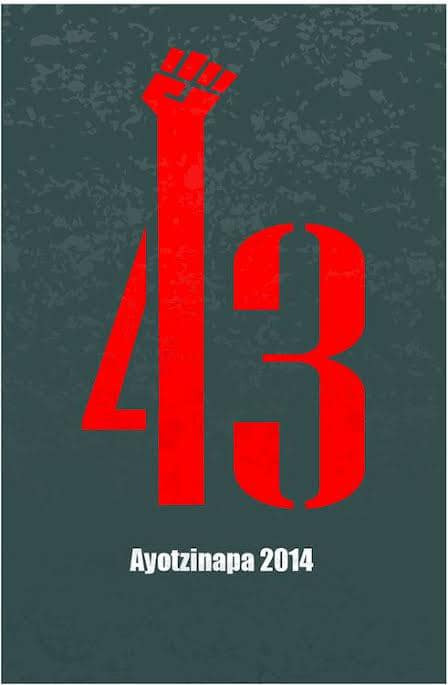
Anónimo, 43. Ayotzinapa, 2014, Imágenes en Voz Alta.
SUS NOMBRES, SUS EDADES.
Felipe Arnulfo Rosa. 20 años.
Benjamín Ascencio Bautista. 19 años.
José Ángel Navarrete González. 18 años.
Marcial Pablo Baranda. 20 años.
Jorge Antonio Tizapa Legideño. 19 años.
Miguel Ángel Mendoza Zacarías. 33 años.
Marco Antonio Gómez Molina.
César Manuel González Hernández.
Julio César López Patolzin. 25 años.
Abel García Hernández. 21 años.
Emiliano Alen Gaspar de la Cruz. 23 años.
Doriam González Parral. 19 años.
Jorge Luis González Parral. 21 años.
Alexander Mora Venancio. 21 años.
Saúl Bruno García.
Luis Ángel Abarca Carrillo. 18 años.
Jorge Álvarez Nava. 19 años.
Christian Tomás Colón Garnica. 18 años.
Luis Ángel Francisco Arzola. 20 años.
Carlos Iván Ramírez Villarreal 20 años.
Magdaleno Rubén Lauro Villegas. 19 años.
José Luis Luna Torres. 20 años.
Bernardo Flores Alcaraz.
Israel Caballero Sánchez. 21 años.
Arturo Vázquez Peniten.
Jesús Jovany Rodríguez Tlatempa. 21 años
Mauricio Ortega Valerio. 18 años.
José Ángel Campos Cantor.
Jorge Aníbal Cruz Mendoza. 19 años,
Giovanni Galindes Guerrero. 20 años.
Jhosivani Guerrero de la Cruz. 21 años.
Leonel Castro Abarca. 18 años.
Miguel Ángel Hernández Martínez. 27 años.
Antonio Santana Maestro.
Carlos Lorenzo Hernández Muñoz. 19 años
Israel Jacinto Lugardo. 19 años.
Adán Abraján de la Cruz. 24 años.
Christian Alfonso Rodríguez. 21 años
Martín Getsemany Sánchez García. 20 años.
Cutberto Ortiz Ramos. 22 años.
Everardo Rodríguez Bello. 21 años.
Jonás Trujillo González. 20 años.
José Eduardo Bartolo Tlatempa. 19 años.
5 notes
·
View notes
Text
2023 Le Mans 24 Hours in pictures
Pictures from the 100th anniversary running of the Le Mans 24 Hours at the Circuit de la Sarthe. Le Mans 24 Hours, 2023 Start, Le Mans 24 Hours, 2023 Start, Le Mans 24 Hours, 2023 Start, Le Mans 24 Hours, 2023 Start, Le Mans 24 Hours, 2023 Start, Le Mans 24 Hours, 2023 Romain Dumas/Olivier Pla/Ryan Briscoe, #708 Glickenhaus 007, Le Mans 24 Hours, 2023 Sebastien Bourdais/Renger Van Der Zande/Scott Dixon, #3 Cadillac V-Series.R, Le Mans 24 Hours, 2023 Franck Mailleux/Nathanael Berthon/Esteban Gutierrez, #709 Glickenhaus 007, Le Mans 24 Hours, 2023 Alessandro Pier Guidi/James Calado/Antonio Giovinazzi, #51 Ferrari 499P, Le Mans 24 Hours, 2023 Sebastien Bourdais/Renger Van Der Zande/Scott Dixon, #3 Cadillac V-Series.R, Le Mans 24 Hours, 2023 Mike Conway/Kamui Kobayashi/Jose Maria Lopez, #7 Toyota GR010, Le Mans 24 Hours, 2023 Alessandro Pier Guidi/James Calado/Antonio Giovinazzi, #51 Ferrari 499P, Le Mans 24 Hours, 2023 Antonio Fuoco/Miguel Molina/Nicklas Nielsen, #50 Ferrari 499P, Le Mans 24 Hours, 2023 Spectators, Le Mans 24 Hours, 2023 Alessandro Pier Guidi/James Calado/Antonio Giovinazzi, #51 Ferrari 499P, Le Mans 24 Hours, 2023 Antonio Fuoco/Miguel Molina/Nicklas Nielsen, #50 Ferrari 499P, Le Mans 24 Hours, 2023 Sebastien Buemi/Brendon Hartley/Ryo Hirakawa, #8 Toyota GR010, Le Mans 24 Hours, 2023 Mike Conway/Kamui Kobayashi/Jose Maria Lopez, #7 Toyota GR010, Le Mans 24 Hours, 2023 Mike Conway/Kamui Kobayashi/Jose Maria Lopez, #7 Toyota GR010, Le Mans 24 Hours, 2023 Loic Duval/Gustavo Menezes/Nico Mueller, #94 Peugeot 9X8, Le Mans 24 Hours, 2023 Dane Cameron/Michael Christensen/Frederic Makowiecki, #5 Porsche 963, Le Mans 24 Hours, 2023 Spectators, Le Mans 24 Hours, 2023 Felipe Nasr/Mathieu Jaminet/Nicholas Tandy, Porsche 963, Le Mans 24 Hours, 2023 Earl Bamber/Alex Lynn/Richard Westbrook, Cadillac V-Series.R, Le Mans 24 Hours, 2023 Sebastien Bourdais/Renger Van Der Zande/Scott Dixon, #3 Cadillac V-Series.R, Le Mans 24 Hours, 2023 Felipe Nasr/Mathieu Jaminet/Nicholas Tandy, Porsche 963, Le Mans 24 Hours, 2023 Antonio Fuoco/Miguel Molina/Nicklas Nielsen, #50 Ferrari 499P, Le Mans 24 Hours, 2023 Earl Bamber/Alex Lynn/Richard Westbrook, Cadillac V-Series.R, Le Mans 24 Hours, 2023 Antonio Felix Da Costa/Will Stevens/Yifei Ye, #38 Porsche 963, Le Mans 24 Hours, 2023 Antonio Fuoco/Miguel Molina/Nicklas Nielsen, #50 Ferrari 499P, Le Mans 24 Hours, 2023 Alessandro Pier Guidi/James Calado/Antonio Giovinazzi, #51 Ferrari 499P, Le Mans 24 Hours, 2023 Antonio Fuoco/Miguel Molina/Nicklas Nielsen, #50 Ferrari 499P, Le Mans 24 Hours, 2023 Mike Conway/Kamui Kobayashi/Jose Maria Lopez, #7 Toyota GR010, Le Mans 24 Hours, 2023 Mike Conway/Kamui Kobayashi/Jose Maria Lopez, #7 Toyota GR010, Le Mans 24 Hours, 2023 Alessandro Pier Guidi/James Calado/Antonio Giovinazzi, Ferrari 499P, Le Mans 24 Hours, 2023 Luis Felipe Derani/Alexander Sims/Jack Aitken, #311 Cadillac V-Series.R, Le Mans 24 Hours, 2023 Sebastien Buemi/Brendon Hartley/Ryo Hirakawa, #8 Toyota GR010, Le Mans 24 Hours, 2023 Mike Conway/Kamui Kobayashi/Jose Maria Lopez, #7 Toyota GR010, Le Mans 24 Hours, 2023 Marshal, Le Mans 24 Hours, 2023 Le Mans 24 Hours, 2023 Le Mans 24 Hours, 2023 Sebastien Buemi/Brendon Hartley/Ryo Hirakawa, Toyota GR010, Le Mans 24 Hours, 2023 Le Mans 24 Hours, 2023 Dane Cameron/Michael Christensen/Frederic Makowiecki, Porsche 963, Le Mans 24 Hours, 2023 Sebastien Buemi/Brendon Hartley/Ryo Hirakawa, Toyota GR010, Le Mans 24 Hours, 2023 World Endurance Championship Browse all World Endurance Championship articles via RaceFans - Independent Motorsport Coverage https://www.racefans.net/
3 notes
·
View notes
Text
PREDICTIONS of those in attendance of The Princess of Asturias's 18th birthday Celebrations
The Princess of Asturias's birthday celebration is meant to be a private affair, thus likely there will be limilted international affairs involved and it will primarily be a family affair, if anything we might get The Greeks as Queen Sofia is closely connected to them, and possibly the Bulgarian royals, especially with Prince Christian's celebrations just the week before.
Spain
King Felipe VI
Queen Letizia
Queen Sofia
King Juan Carlos
Infanta Elena, The Duchess of Lugo
Don Felipe Juan Froilán de Todos los Santos de Marichalar y Borbón, Lord of Tejada
Doña Victoria Federica de Todos los Santos de Marichalar y Borbón, Lady of Tejada
Infanta Cristina
Don Juan Valentín Urdangarin y Borbón
Don Pablo Nicolás Sebastián Urdangarin y de Borbón
Don Miguel Urdangarin y Borbón
Doña Irene Urdangarin y Borbón
Doña María de Fátima Simoneta Luisa Gómez-Acebo y Borbón(who's also celebrating her birthday)
Don Juan Filiberto Nicolás Gómez-Acebo y Borbón, 3rd Viscount of La Torre
Don Bruno Alejandro Gómez-Acebo y Borbón
Don Luis Beltrán Ataúlfo Alfonso Gómez-Acebo y Borbón
Don Fernando Humberto Gómez-Acebo y Borbón
Infanta Margarita of Spain, Duchess of Soria, 2nd Duchess of Hernani, Grandee of Spain
Don Carlos Emilio Juan Zurita y Delgado, Duke of Soria and Hernani
Don Alfonso Juan Carlos Zurita y de Borbón, Grandee of Spain
Doña María Sofía Emilia Carmen Zurita y de Borbón, Grandee of Spain
Queen Letizia's family
Jesús José Ortiz Álvarez
María de la Paloma Rocasolano Rodríguez
Telma Ortiz Rocasolano
Amanda Rocasolano
Carla Vigo Rocasolano
1 note
·
View note